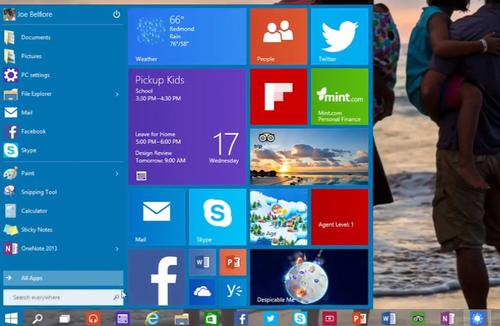Windows 10 Undoes the Disaster of Windows 8
oday, Microsoft took the wraps off the next version of Windows. You’ll be able to install a free, unfinished “technical preview” version this week, or get it in final form sometime next year. It’s calledWindows 10.
(Why is it Windows 10? What happened to 9? Making sense of the Windows naming sequence is like solving one of those Mensa “What’s the pattern?” puzzles. So far, we have this: Windows 1, 2, 3, 95, 98, 2000, ME, XP, Vista, 7, 8, 10. OK, whatever.)
Windows 8, as the world now knows, was a superimposed mishmash of two operating systems. There was the touchscreen-friendly TileWorld interface, as I called it. (Microsoft, at various times, called it Modern or Metro; it has officially retired both of those terms and replaced them with nothing.)
And, underneath, there was the regular desktop:

They are quite separate, these two environments. Each has its own Help system, its own Web browser, its own email program, its own control panel, its own conventions and gestures. Worse, each runs its own kind of programs. Regular Windows programs open at the desktop, as always — but TileWorld apps open in TileWorld, with no menus overlapping windows. Like iPad apps.
Microsoft believed at the time (2012) that the world was going touchscreen crazy. That, sooner or later, every PC would have a touchscreen.
Betting on bothIt bet wrong. Most computers still don’t have touchscreens. Windows 8 was a massive flop with critics. “Windows 8 is a failure — an awkward mishmash that pulls the user in two directions at once,” wrote Woody Leonhard in InfoWorld. “A horribly awkward mashup of two fundamentally incompatible approaches that worked poorly on both PCs and tablets,” wrote Galen Gruman.
Windows 8 was a massive flop with consumers, too. Today, 51 percent of desktop PCs still run Windows 7; only 13 percent have “upgraded” to Windows 8 or 8.1, according to Net Applications.
And at the Windows 10 announcement, you would not have believedthe words coming out of Microsoft’s mouth.
“In Windows 8, when users launched a Modern [TileWorld] app, it sort of had a different environment,” OS Group VP Joe Belfiore said in his demo. “We don’t want that duality.”
Now, when I wrote exactly that in The New York Times, Microsoft PR descended on me like the beasts of hell.
The answer has always been screamingly obvious: Split up the two halves of Windows 8. Or, as a wise man once wrote, “Put TileWorld and its universe of new touchscreen apps on tablets. Put Windows 8 on mouse-and-keyboard PCs.” (OK, it was me.)
Anyway, here’s the big news: In Windows 10, Microsoft has done just that.
Mouse-and-keyboard modeIf you use Windows 10 with a mouse and keyboard, the Start menu is back. Not just the Start button, not just the secret Windows key+X utility menu of Windows 8.1 — the real Start menu.
And TileWorld is gone. No more screen of big flat tiles taking over your monitor.
Tiles aren’t gone completely; they still pop out of the regular Start menu, a little weirdly.

And what about all those TileWorld apps that could run only in TileWorld? Since TileWorld is gone, these apps now open up on the desktop, in regular windows with regular title bars and window controls. You can still see your desktop, and you can see TileWorld apps and regular Windows programs side by side
No comments:
Post a Comment